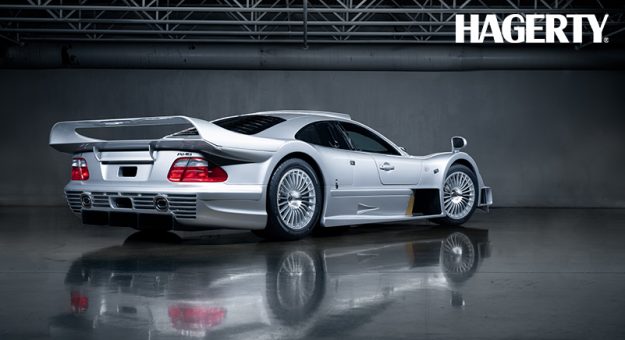By Grace Houghton
When Mercedes-Benz decided to compete in the FIA’s newly minted GT Championship in 1997, its commitment was full-on. In 128 days, it built two prototypes based (in name only) on the CLK coupe. Lest you think the effort was ill-informed or overly rushed, know that Mercedes also managed to buy an F1 LM from a French privateer team. In solemn secrecy, German engineers tore off the F1’s front and rear clips, built new ones, extracted the BMW-sourced engine, and repurposed the McLaren as a test mule for its own M120 V-12.
Even the 25 FIA-mandated homologation run reflects Mercedes’ incredible focus. Barely tamed, yet with a thoughtful array of well-executed creature comforts, the street-legal CLK GTR is anything but a clapped-together homologation special. Years later, this 1998 example, up for auction at Gooding & Company’s Pebble Beach sale, is a highly desirable piece of Mercedes’ motorsports story.

The skeleton of the CLK GTR Strassenversion is a carbon-fiber and aluminum monocoque; its heart is a 6898-cc, naturally aspirated V-12. Dubbed M297, this 6.9-liter, aluminum-block mill is essentially a stroked version of the race car’s M120 V-12. The two share a 89-mm stroke, but the larger engine in the road-going car has a 92.4-mm stroke to the race-spec engine’s 91.5. (Fun fact: A descendant of the M297 powered the Pagoni Zonda until 2016, a 7.3-liter affair with a 91.5-mm bore.) All this howling German ferocity—612 hp—nestles just aft of your skull, ahead of the rear axle.
The gearbox is a six-speed Xtrac sequential unit with shift paddles mounted on the steering wheel, which distinguishes itself as the only removable wheel containing an airbag. Ventilated ceramic discs sit on all four corners, and the suspension is similarly symmetrical: independent wishbones and coil-overs all around. Concessions to everyday highways and byways include a higher ride height and more compliant suspension, compared to the competition cars. However competent the handling, the 15.9-foot-long CLK GTR is hardly nimble in a parking lot: this silver monster boasts a turning radius of over 49 feet.

Though Mercedes-AMG didn’t participate in the 24 Hours of Le Manus during its inaugural season, the CLK GTR won six of the 11 rounds of the ’97 GT1 Championship, with victories at the Nürburgring, A1-Ring, Donington, Sebring, Laguna Seca, and Suzuka. In addition to the manufacturers championship, Mercedes also took top honors in the drivers’ standings, with the German Bernd Schneider finishing ahead of two BMW drivers. 1998 saw Mercedes-AMG expand its victories into total dominance, with ten out of ten rounds. The CLK GTR, however, could only take credit for the first two victories in 1998, at Oschersleben and Silverstone; Mercedes-AMG replaced it with the Le-Mans-eligible CLK LM for the rest of the season. In addition to aerodynamic tweaks to the bodywork, the LM model used a M119 HL V-8 (rather than the M120 V-12 of the GTR versions) shorn of its two turbochargers and rechristened the GT108 B.
The last time a CLK GTR surfaced on a U.S. auction block was in 2018, when RM Sotheby’s sold this same car—chassis #9—for $4,515,000, also in Monterey. Values of the CLK GTR’s contemporaries (McLaren F1 and the like) have increased by roughly a third since 2018, which could bode well for Mercedes’ ’90s-era endurance-racing homologation special. If chassis #9 clears $8,500,000, the low end of its presale estimate, it’ll underscore the rising tide of ’90s car values—especially for vehicles of this special sort.

Imported to the U.S. in 2017 under the Show or Display exemption, this CLK GTR is in exceptionally original condition and shows only 1442 kilometers (896 miles); records included with the sale show that it’s been driven a mere 40 km each year, on average, since 2005. Rare and pedigreed, chassis #9 captures the brilliant yet raw-edged spirit of ’90s endurance racing and would be a total show-stopper in any Mercedes or motorsports collection.
Enjoying this article? Sign up for Hagerty’s newsletters to see more like it.



